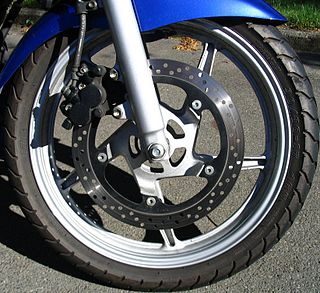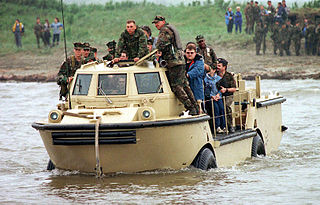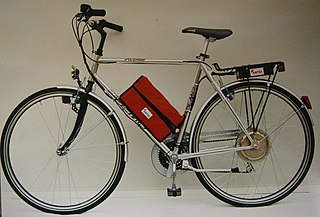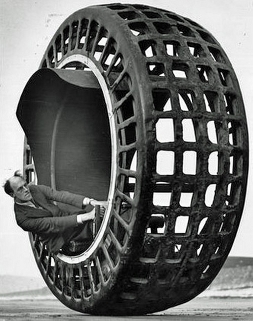
An open-wheel single-seater is a car with the wheels outside the car's main body, and usually having only one seat. Open-wheel cars contrast with street cars, sports cars, stock cars, and touring cars, which have their wheels below the body or inside fenders. Open-wheel cars are built both for road racing and oval track racing. Street-legal open-wheel cars, such as the Ariel Atom, are scarce as they are often impractical for everyday use.

A brake is a mechanical device that inhibits motion by absorbing energy from a moving system. It is used for slowing or stopping a moving vehicle, wheel, axle, or to prevent its motion, most often accomplished by means of friction.

An amphibious vehicle, is a vehicle that is a means of transport viable on land as well as on or under water. Amphibious vehicles include amphibious bicycles, ATVs, cars, buses, trucks, railway vehicles, combat vehicles and hovercraft.

An electric unicycle is a self-balancing personal transporter with a single wheel. The rider controls speed by leaning forwards or backwards, and steers by twisting or tilting the unit side to side. The self-balancing mechanism uses accelerometers, gyroscopes, and a magnetometer. In 2020, suspension models were introduced by three major manufacturers Begode, Kingsong and Inmotion.

An all-terrain vehicle (ATV), also known as a light utility vehicle (LUV), a quad bike or quad, as defined by the American National Standards Institute (ANSI), is a vehicle that travels on low-pressure tires, has a seat that is straddled by the operator, and has handlebars. As the name implies, it is designed to handle a wider variety of terrain than most other vehicles. It is street-legal in some countries, but not in most states, territories and provinces of Australia, the United States, and Canada.

A feet first (FF) motorcycle is a class of motorcycle design which positions the rider with their feet ahead, like a car, rather than below and astride, as with conventional bikes. As there are other types of motorcycle that have a 'feet forward' position, an alternative term sometimes used is advanced single track vehicle. The name "feet first" was first used by Royce Creasey

A manual transmission (MT), also known as manual gearbox, standard transmission, or stick shift, is a multi-speed motor vehicle transmission system, where gear changes require the driver to manually select the gears by operating a gear stick and clutch.

The Eliica is a battery electric vehicle prototype or concept car first shown in 2004 and designed by a team at Keio University in Tokyo, led by Professor Hiroshi Shimizu. The 5.1 m (17 ft) car runs on a lithium-ion battery and can accelerate from 0–100 km/h (62 mph) in four seconds. In 2004, the Eliica reached a speed of 370 km/h (230 mph) on Italy's Nardò High Speed Track. The team's goal is to exceed 400 km/h (250 mph), breaking the record set by today's street-legal gasoline-powered vehicles.

A three-wheeler is a vehicle with three wheels. Some are motorized tricycles, which may be legally classed as motorcycles, while others are tricycles without a motor, some of which are human-powered vehicles and animal-powered vehicles.

A monowheel, or uniwheel, is a one-wheeled single-track vehicle similar to a unicycle.

A motorized bicycle is a bicycle with an attached motor or engine and transmission used either to power the vehicle unassisted, or to assist with pedalling. Since it sometimes retains both pedals and a discrete connected drive for rider-powered propulsion, the motorized bicycle is in technical terms a true bicycle, albeit a power-assisted one. Typically they are incapable of speeds above 52 km/h (32 mph), however in recent years larger motors have been built, allowing bikes to reach speeds of upwards of 72 km/h.

An electric bicycle is a motorized bicycle with an integrated electric motor used to assist propulsion. Many kinds of e-bikes are available worldwide, but they generally fall into two broad categories: bikes that assist the rider's pedal-power and bikes that add a throttle, integrating moped-style functionality. Both retain the ability to be pedaled by the rider and are therefore not electric motorcycles. E-bikes use rechargeable batteries and typically are motor-powered up to 25 to 32 km/h. High-powered varieties can often travel more than 45 km/h (28 mph).

The Chevrolet Engineering Research Vehicle (CERV) is a series of Chevrolet experimental cars. Chevrolet Staff engineer, designer, and race car driver Zora Arkus-Duntov started development of the CERV I in 1959, and began work on the CERV II in 1963. Chevrolet chief engineer Don Runkle and Lotus' Tony Rudd discussed creating a new show car to demonstrate their engineering expertise in 1985; It would become the CERV III. Corvette chief engineer Dave Hill unveiled the CERV IV in 1993, a test vehicle for the 1997 C5 Corvette.
Hybrid vehicle drivetrains transmit power to the driving wheels for hybrid vehicles. A hybrid vehicle has multiple forms of motive power.
Toyota Concept Vehicles produced between 1980 and 1989 include:

The wheel hub motor is an electric motor that is incorporated into the hub of a wheel and either has direct-drive or planetary gears.

A scooter is a motorcycle with an underbone or step-through frame, a seat, and a platform for the rider's feet, emphasizing comfort and fuel economy. Elements of scooter design were present in some of the earliest motorcycles, and motor scooters have been made since at least 1914.

The Dynasphere was a monowheel vehicle design patented in 1930 by John Archibald Purves FRSE from Taunton, Somerset, UK. Purves' idea for the vehicle was inspired by a sketch made by Leonardo da Vinci.

The Lister Auto-Truck was a small monowheel tractor built for moving light loads around factories, railway yards and similar sites. They were based on a design originally by Auto Mowers Ltd, and were built by R A Lister and Company of Dursley, Gloucestershire, well known for their range of small stationary engines. A narrow-gauge rail version of the Auto-Truck was made along similar stylistic lines as regards the bonnetted engine, and its light weight made it popular for temporary and lightly laid tracks such as used on brickworks, peat bogs, and construction sites. Production of both the Auto-Truck and the Rail-Truck extended from the 1920s to the 1970s.

The Ferrari SF90 Stradale is a mid-engine PHEV sports car produced by the Italian automobile manufacturer Ferrari. The car shares its name with the SF90 Formula One car with SF90 standing for the 90th anniversary of the Scuderia Ferrari racing team and "Stradale" meaning "made for the road".

















